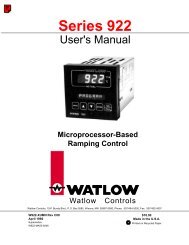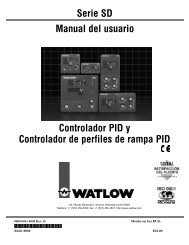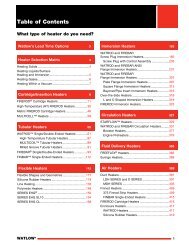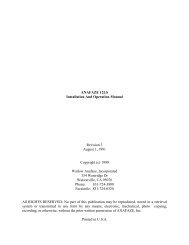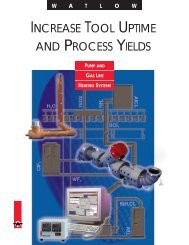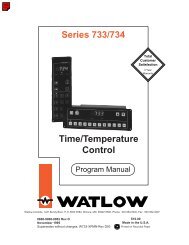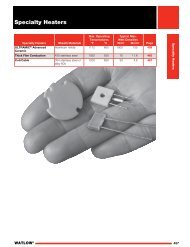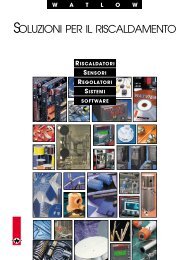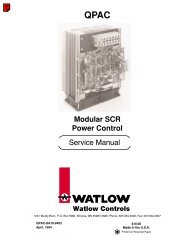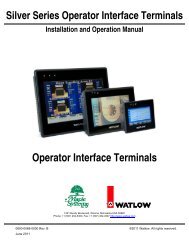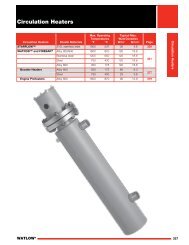pid practical guide.pdf - Watlow
pid practical guide.pdf - Watlow
pid practical guide.pdf - Watlow
You also want an ePaper? Increase the reach of your titles
YUMPU automatically turns print PDFs into web optimized ePapers that Google loves.
deviation will be referred to as offset. Regardless of what you call it or how you define theIntegral parameters the bottom line functionality of the Integral action corrects for the offsetby increasing and or decreasing the output over time so that the proportional band and setpoint are equal.Whenever the process variable is away from set point (offset), there's a proportionalerror signal, which is the first response of the Proportional, Integral, and Derivative controlfunction. If the proportional error signal is not reduced to zero, the Integral mode will repeatthe proportional error signal to the output, at the rate specified by the Integral value. It willcontinue this function until the proportional error has been reduced to zero or the output hasincreased to 100%. When the process variable is at set point with no proportional error, theoutput will remain at the level that the Integral action has reached. The Integral contributionis not only changing the output of the controller by the amount of the proportional bandchange, but at the rate of change of its setting; remember, the Integral contribution is afunction of time. We can see now that if using seconds per repeat, a lower entry will delivermore repeats of the Proportional correction to the output in a shorter period of time, thus theoutput will be faster in response. A <strong>practical</strong> useful range for this setting would be between30 to 1200 seconds per repeat and 2.0 to 0.05 repeats per minute for Reset. A settingbelow 30 seconds will normally cause output oscillations, and a setting above 1200seconds is normally too slow.The general rule for setting T i is that the faster the process, the lower the T i , the slowerthe process, the higher the T i . A process that comes to a new control point after a stepchange in 20 minutes is considered fast; after 1 hour, it is considered slow. Settings below60 seconds are considered fast; settings above 600 seconds are considered slow. Settingsof 60, 120, 180, and 240 seconds handle most processes.To produce a 100% change in the output, with a proportional band of 20 and a Integralvalue equal to 60, a 1° change in the process variable would result in a 5% change in theoutput. The Integral setting would result in a 95% change in the output in a time frame of 19Minutes.100% output - 5% proportional band = 95%/5% (1 R/M) = 19 minutesAn Integral value, which is too high, will not allow the process variable to come to setpoint within a reasonable amount of time. A low Integral value will cause the output tooscillate, thus causing the process variable to cycle at a slow rate. This is called Resetcycling.To bring more clarity to the discussion above, the graph below (figure 2.1) clearlydepicts the response of a control with the PB set at 50. Introducing a 10° change in theprocess variable from the set point causes the first response to be that of the Proportionalcontribution. Due to the fact that every degree change on the process variable translatesto a 2% rise in the output we can clearly see an overall jump of 20% immediately after thestep change occurs. Thereafter, we can also see the Integral contribution repeating the20% Proportional response to the output at the rate of 30 seconds a repeat.8



